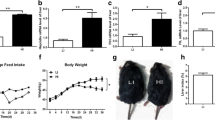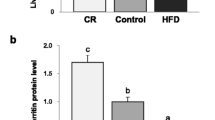Abstract
Purpose
Since obesity is associated with poorer iron status, the effects of diet-induced obesity on iron status and iron-regulatory pathways were examined.
Methods
Weanling male diet-induced obese sensitive (n = 12/diet group) and resistant (n = 12/diet group) rats were fed one of four high-fat, high-energy diets supplemented with 5 (5Fe, low), 15 (15Fe, marginal), 35 (35Fe, normal) or 70 (70Fe, high) mg iron/kg diet for 12 weeks. At the end of the study, rats in each diet group were categorised as obese (>19 %) or lean (<17 %) based on percentage body fat.
Results
Obese rats gained more weight, had larger total lean mass, consumed more food and showed greater feed efficiency compared with lean rats. Obese rats fed the 5Fe and 15Fe diets had poorer iron status than lean rats fed the same diet. Obese 5Fe rats had lower serum iron and more severe iron-deficiency anaemia. Obese 15Fe rats had lower mean corpuscular haemoglobin and liver iron concentrations. Hepcidin mRNA expression in liver and adipose tissue was similar for obese and lean rats. Iron concentration and content of the iron transporters divalent metal transporter 1 and ferroportin 1 in duodenal mucosa were also similar.
Conclusions
Obese rats that were larger, regardless of adiposity, had higher iron requirements compared with lean rats that appeared independent of hepcidin, inflammation and intestinal iron absorption. Higher iron requirements may have resulted from larger accretion of body mass and blood volume. Greater food consumption did not compensate for the higher iron needs, indicating increased susceptibility to iron deficiency.




Similar content being viewed by others
References
Stoltzfus R (2001) Defining iron-deficiency anemia in public health terms: a time for reflection. J Nutr 131(2S-2):565S–567S
Zimmermann MB, Hurrell RF (2007) Nutritional iron deficiency. Lancet 370(9586):511–520
Brownlie T 4th, Utermohlen V, Hinton PS, Giordano C, Haas JD (2002) Marginal iron deficiency without anemia impairs aerobic adaptation among previously untrained women. Am J Clin Nutr 75(4):734–742
Brownlie T 4th, Utermohlen V, Hinton PS, Haas JD (2004) Tissue iron deficiency without anemia impairs adaptation in endurance capacity after aerobic training in previously untrained women. Am J Clin Nutr 79(3):437–443
Gardner GW, Edgerton VR, Senewiratne B, Barnard RJ, Ohira Y (1977) Physical work capacity and metabolic stress in subjects with iron deficiency anemia. Am J Clin Nutr 30(6):910–917
Murray-Kolb LE, Beard JL (2007) Iron treatment normalizes cognitive functioning in young women. Am J Clin Nutr 85(3):778–787
Nead KG, Halterman JS, Kaczorowski JM, Auinger P, Weitzman M (2004) Overweight children and adolescents: a risk group for iron deficiency. Pediatrics 114(1):104–108
Pinhas-Hamiel O, Newfield RS, Koren I, Agmon A, Lilos P, Phillip M (2003) Greater prevalence of iron deficiency in overweight and obese children and adolescents. Int J Obes Relat Metab Disord 27(3):416–418
Lecube A, Carrera A, Losada E, Hernandez C, Simo R, Mesa J (2006) Iron deficiency in obese postmenopausal women. Obesity (Silver Spring) 14(10):1724–1730
Yanoff LB, Menzie CM, Denkinger B, Sebring NG, McHugh T, Remaley AT et al (2007) Inflammation and iron deficiency in the hypoferremia of obesity. Int J Obes (Lond) 31(9):1412–1419
Menzie CM, Yanoff LB, Denkinger BI, McHugh T, Sebring NG, Calis KA et al (2008) Obesity-related hypoferremia is not explained by differences in reported intake of heme and nonheme iron or intake of dietary factors that can affect iron absorption. J Am Diet Assoc 108(1):145–148
Cepeda-Lopez AC, Osendarp SJ, Melse-Boonstra A, Aeberli I, Gonzalez-Salazar F, Feskens E et al (2011) Sharply higher rates of iron deficiency in obese Mexican women and children are predicted by obesity-related inflammation rather than by differences in dietary iron intake. Am J Clin Nutr 93(5):975–983
McClung JP, Karl JP (2009) Iron deficiency and obesity: the contribution of inflammation and diminished iron absorption. Nutr Rev 67(2):100–104
Zafon C, Lecube A, Simo R (2010) Iron in obesity. An ancient micronutrient for a modern disease. Obes Rev 11(4):322–328
Ganz T, Nemeth E (2012) Hepcidin and iron homeostasis. Biochim Biophys Acta 1823(9):1434–1443
Ganz T (2012) Macrophages and systemic iron homeostasis. J Innate Immun 4(5–6):446–453
Sonnweber T, Ress C, Nairz M, Theurl I, Schroll A, Murphy AT et al (2012) High-fat diet causes iron deficiency via hepcidin-independent reduction of duodenal iron absorption. J Nutr Biochem 23(12):1600–1608
Shields M, Carroll MD, Ogden CL (2011) Adult obesity prevalence in Canada and the United States. NCHS Data Brief 56(56):1–8
Roberts KC, Shields M, de Groh M, Aziz A, Gilbert JA (2012) Overweight and obesity in children and adolescents: results from the 2009 to 2011 Canadian Health Measures Survey. Health Rep 23(3):37–41
Reeves PG, Nielsen FH, Fahey GC Jr (1993) AIN-93 purified diets for laboratory rodents: final report of the American Institute of Nutrition ad hoc writing committee on the reformulation of the AIN-76A rodent diet. J Nutr 123(11):1939–1951
Aziz AA, Kenney LS, Goulet B, Abdel-Aal ES (2009) Dietary starch type affects body weight and glycemic control in freely fed but not energy-restricted obese rats. J Nutr 139(10):1881–1889
Boustany CM, Bharadwaj K, Daugherty A, Brown DR, Randall DC, Cassis LA (2004) Activation of the systemic and adipose renin-angiotensin system in rats with diet-induced obesity and hypertension. Am J Physiol Regul Integr Comp Physiol 287(4):R943–R949
Cockell KA, Fischer PW, Belonje B (1999) Elemental composition of anatomically distinct regions of rat liver. Biol Trace Elem Res 70(3):251–263
Levin BE, Dunn-Meynell AA, Balkan B, Keesey RE (1997) Selective breeding for diet-induced obesity and resistance in Sprague-Dawley rats. Am J Physiol 273(2 Pt 2):R725–R730
Farley C, Cook JA, Spar BD, Austin TM, Kowalski TJ (2003) Meal pattern analysis of diet-induced obesity in susceptible and resistant rats. Obes Res 11(7):845–851
Chang S, Graham B, Yakubu F, Lin D, Peters JC, Hill JO (1990) Metabolic differences between obesity-prone and obesity-resistant rats. Am J Physiol 259(6 Pt 2):R1103–R1110
Levin BE, Hogan S, Sullivan AC (1989) Initiation and perpetuation of obesity and obesity resistance in rats. Am J Physiol 256(3 Pt 2):R766–R771
Levin BE, Sullivan AC (1989) Glucose-induced sympathetic activation in obesity-prone and resistant rats. Int J Obes 13(2):235–246
Angelucci E, Brittenham GM, McLaren CE, Ripalti M, Baronciani D, Giardini C et al (2000) Hepatic iron concentration and total body iron stores in thalassemia major. N Engl J Med 343(5):327–331
Knight GJ, Heese Hde V, Dempster WS, Kirsten G (1983) Diagnosis of iron deficiency: mean corpuscular hemoglobin (MCH) as a predictor of iron deficiency in infants. Pediatr Res 17(2):168–170
Hunter JE (1978) Variable effects of iron status on the concentration of ferritin in rat plasma, liver, and spleen. J Nutr 108(3):497–505
Ward C, Saltman P, Ripley L, Ostrup R, Hegenauer J, Hatlen L et al (1977) Correlation of serum ferritin and liver ferritin iron in the anemic, normal, iron-loaded rat. Am J Clin Nutr 30(7):1054–1063
Pigeon C, Ilyin G, Courselaud B, Leroyer P, Turlin B, Brissot P et al (2001) A new mouse liver-specific gene, encoding a protein homologous to human antimicrobial peptide hepcidin, is overexpressed during iron overload. J Biol Chem 276(11):7811–7819
Flanagan JM, Truksa J, Peng H, Lee P, Beutler E (2007) In vivo imaging of hepcidin promoter stimulation by iron and inflammation. Blood Cells Mol Dis 38(3):253–257
Chung J, Kim MS, Han SN (2011) Diet-induced obesity leads to decreased hepatic iron storage in mice. Nutr Res 31(12):915–921
Krause A, Neitz S, Magert HJ, Schulz A, Forssmann WG, Schulz-Knappe P et al (2000) LEAP-1, a novel highly disulfide-bonded human peptide, exhibits antimicrobial activity. FEBS Lett 480(2–3):147–150
Park CH, Valore EV, Waring AJ, Ganz T (2001) Hepcidin, a urinary antimicrobial peptide synthesized in the liver. J Biol Chem 276(11):7806–7810
Bekri S, Gual P, Anty R, Luciani N, Dahman M, Ramesh B et al (2006) Increased adipose tissue expression of hepcidin in severe obesity is independent from diabetes and NASH. Gastroenterology 131(3):788–796
Chung B, Matak P, McKie AT, Sharp P (2007) Leptin increases the expression of the iron regulatory hormone hepcidin in HuH7 human hepatoma cells. J Nutr 137(11):2366–2370
Ganz T (2003) Hepcidin, a key regulator of iron metabolism and mediator of anemia of inflammation. Blood 102(3):783–788
Baumgartner J, Smuts CM, Aeberli I, Malan L, Tjalsma H, Zimmermann MB (2013) Overweight impairs efficacy of iron supplementation in iron-deficient South African children: a randomized controlled intervention. Int J Obes (Lond) 37(1):24–30
Sanad M, Osman M, Gharib A (2011) Obesity modulate serum hepcidin and treatment outcome of iron deficiency anemia in children: a case control study. Ital J Pediatr 37:34
Cepeda-Lopez AC, Aeberli I, Zimmermann MB (2010) Does obesity increase risk for iron deficiency? A review of the literature and the potential mechanisms. Int J Vitam Nutr Res 80(4–5):263–270
Whittaker P, Mahoney AW, Hendricks DG (1984) Effect of iron-deficiency anemia on percent blood volume in growing rats. J Nutr 114(6):1137–1142
Schreihofer AM, Hair CD, Stepp DW (2005) Reduced plasma volume and mesenteric vascular reactivity in obese zucker rats. Am J Physiol Regul Integr Comp Physiol 288(1):R253–R261
Astrup A (1996) Obesity and metabolic efficiency. Ciba Found Symp 201:159–193
Acknowledgments
We thank Dominique Patry for assistance with the haematological, serum iron and adipokine analyses. We are also grateful to Véronique Gagné, Michelle Lalande, Jocelyn Souligny and Rudi Mueller for care of the rats and assistance with the necropsies. This research was funded by the Bureau of Nutritional Sciences, Health Canada.
Conflict of interest
The authors declare that they have no conflict of interest.
Author information
Authors and Affiliations
Corresponding author
Electronic supplementary material
Below is the link to the electronic supplementary material.
Rights and permissions
About this article
Cite this article
Bertinato, J., Aroche, C., Plouffe, L.J. et al. Diet-induced obese rats have higher iron requirements and are more vulnerable to iron deficiency. Eur J Nutr 53, 885–895 (2014). https://doi.org/10.1007/s00394-013-0592-9
Received:
Accepted:
Published:
Issue Date:
DOI: https://doi.org/10.1007/s00394-013-0592-9




